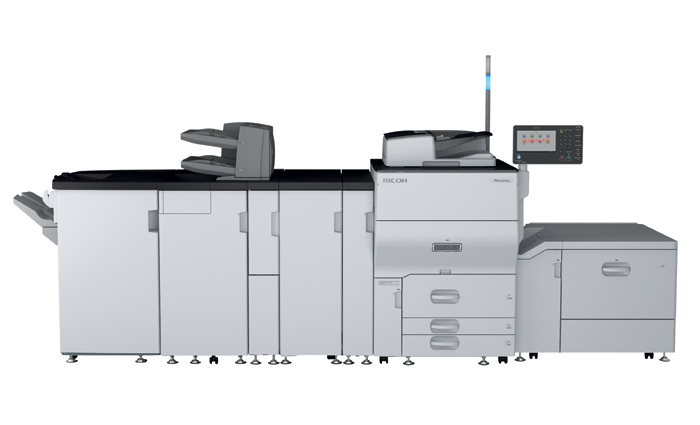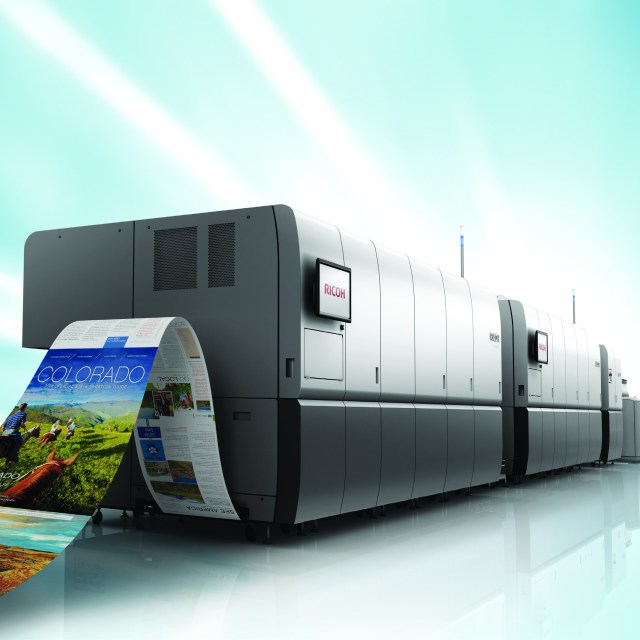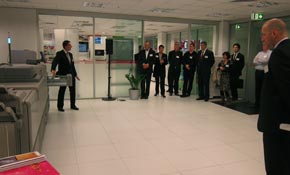
The Ricoh Pro C5100S sits beneath the rest of Ricoh’s production colour machines – but only in one respect. The light production machine has a lower intended monthly page volume than the Ricoh Pro C651, C751 and C901. According to Ricoh product marketing manager Dave Gully, this is significant. It means the C5100S – and its sister machine, the Pro C5110 – offers the sophistication and quality of its bigger siblings without the additional grunt that some users just don’t need.
The target range is up to 150,000 A4 pages per month, although the duty cycle is 300,000 for those months when it gets a real hammering. The target market is expected to be well below the 150,000 mark. To put that into context, 150,000 A4 sides is 75,000 A3 sides or 37,500 A3 sheets if printing duplex. So if you’re running the Pro C5100S, which reaches 65ppm, for five days a week for a month, it would reach those 150,000 A4 pages operating just two hours a day. The 80ppm Pro C5110S would be running for even less time before it hit that number.
Likely markets include quick printers, corporate inplants and marketing and design agencies looking to insource their print production. Within the agency market, it is likely to find a place for producing samples, book proofs and even packaging mock-ups too.
The machine features a number of incremental improvements to Ricoh’s digital printing technology. Considering the improvements to the C901 earlier this year, it is fair to expect Ricoh will keep introducing additional benefits at a fairly rapid clip across its range.
According to Kathy Wilson, general manager of business solutions at Ricoh Australia: “These enhancements are not just the latest bells and whistles for the sake of it, they translate into serious business benefits.”
So what are the new features and what are their benefits? One is enhanced VCSEL diode imaging. VCSEL (you might hear it pronounced ‘vixel’) refers to the type of laser diode used to create the image. It stands for Vertical Cavity Surface Emitting Laser. This class of laser is economic to manufacture, offers high power and, because it can be built in 2D arrays of multiple-beams, enables printing machines that combine high resolution with high speed. Ricoh first introduced the technology in the C751; the C5100 takes it further with a 1,200×4,800dpi resolution. According to Gully, the advantage of the 4,800dpi along the length of the sheets is that it enables the printer more adjustment latitude and the ability to register the image to the leading and trailing edge of the sheet.
Chemical toner itself is not new but the C5100 uses a new generation. Chemical toner refers to the way the particles are grown in a soup of chemicals rather than the more traditional approach of grinding down chunks to a smaller size. Less energy is needed to make the toner and the particles are smaller and more consistent sizes, which means more even and consistent prints. The new toner has two major benefits: lower melting point and wider colour gamut. The colour gamut, which is 10% greater than other Ricoh toners, is caused by a revised cyan formulation, giving better blues and greens.
Ricoh sees the greatest benefit in the lower melting point. This enables heavier, textured and more heat sensitive mat-erials to be handled. The C5100 can handle up to 300gsm either using the bypass tray or an additional optional feed tray. As for an expanded range of substrates, in addition to many already approved stocks in Ricoh’s media library it is working on accrediting more materials.
When it comes to extending the range of materials printed, the new toner is only half the story. The second key element is a new fuser. It incorporates new technology to assist in the transfer and adhesion of the toner to the substrate, which helps it to handle textured stocks, envelopes and lighter weight papers down to 60gsm. This opens up an extended range of applications, and the ability to handle heavier and textured stocks is important for addressing premium quality jobs.
Wider range of stocks
New on the 5100S is the long sheet printing option, which is able to handle sheets up to 1.26-metres long. This builds on the little-known ability of the C751 to handle sheets up to 630mm long. This long sheet ability is something of a trend for digital colour printers but is new in the light production class. Some desktop devices have had the ability for a while, and as such have been suggested for some banner work and even modified for label printing. At the other end of the scale are the long sheet options for the Kodak Nexpress and Xerox iGen4, which successfully increases productivity and application range.
The 5100S is not challenging any of these but it does open up opportunities that the canny print company could exploit for niche applications. The long sheet could be used to produce banners, providing the short edge was less than 323mm. This could be much more cost-effective than using a wide-format printer.
It also opens up the opportunity to produce a range of unusual A4 formats including landscape spreads, gate folds, throw-outs, six-page, eight-page and even A3 landscape spreads, which might prove useful for real estate brochures and photo-books. “We don’t envisage it being a major part of the machine’s workload,” says Gully. “It’s about helping customers to uncover new applications.”
The limitations are that you need to use the bypass tray and need to be careful – potentially standing over the machine feeding and removing long sheets. Duplex printing requires manually feeding.
Additional controller options
There’s a choice of two EFI Fiery controllers, an embedded one or an external one. Users with the desire for more involved colour control and variable data will probably opt for the extra muscle of the external controller, while for less demanding applications the internal controller is the most cost-effective option.
Small footprint
Ricoh has worked hard to minimise the footprint of the basic unit to suit its target market. It accommodates with a footprint of just 835x880mm. For those that have the space and need the additional features, it is possible to add a range of paper feeds and finishing units, although not as many as its bigger siblings. For instance, you can have a saddlestitcher inline but not a perfect binder.
Low power consumption
One of the biggest benefits of the new fuser and toner technologies is it requires less heat, hence the machine uses less power. The C5100S draws less than 1,920W, while the faster C5110S draws less than 2,400W, significantly lower than the other machines in Ricoh’s range. That’s good news – lower energy consumption is a nice sustainability story but it also means lower running costs from reduced electricity bills.
There’s been no official word whether Ricoh’s partner, Heidelberg, will take a version of the C5100S. However, it seems unlikely: even though the story of offering high quality for lower-volume users sits well with Heidelberg’s digital press strategy, the volume here is too low for Heidelberg’s typical customers, who would quickly outgrow the C5100S.
In conclusion, the C5100S is a well-specified addition to the light production market. If you meet the sweet spot of wanting top quality but you don’t anticipate needing high-volume production too it definitely meets a previously unmet need, especially with the long sheet option offering some interesting niche applications.
Specifications
Speed Pro C5100S: 65 A4ppm Pro C5110S: 80 A4ppm
Monthly volume 150,000 (A4)
Duty cycle 300,000 (A4)
RIP options Internal Fiery E-22B, External Fiery E-42B
Finishing options Plockmatic bookletmaker, booklet-finisher, cover feeder, folder and decurler
Paperweight 52-300gsm (over 256gsm requires use of optional feed tray or bypass tray)
Sheet size 320x450mm (excluding long sheet option up to 1,260mm)
Image size 323x480mm (excluding long sheet option up to 1,260mm)
Contact ricoh.com.au, 1800 181 002
The alternatives
Canon ImageRunner 9065
The 65ppm 9065 is the nearest rival to the Pro C5100. Launched in 2009, it’s the oldest of the alternatives and starting to show it. Although Canon has announced refreshed ImageRunner 9000 series products, they don’t appear to be targeting light production.
Speed 65ppm (A4)
Duty Cycle 350,000
Contact Canon, 1800 444 199, www.canon.com.au/pps
Fuji Xerox 550/560
Arguably the leader of the pack in the light production colour space, Fuji Xerox’s 550/560 has been around since 2010 when it was the first of a class of very light production colour devices with an aggressive price point.
Speed 50 or 60 A4ppm
Duty cycle 350,000
Contact (02) 9856 5000, www.fujixerox.com.au
Fuji Xerox C75/J75
Like the Ricoh Pro C5100, the C75 and J75 were launched this year. The C75 and J75 are based on the same core technology but pitched at different markets. The C75 is the top end of the office market while the J75 is the bottom. Both include Xerox’s built-in colour calibration technology and Simple Image Quality Adjustment, which is an operator-initiated process for maintaining colour density and front-to-back registration.
Speed 75A4ppm
Duty cycle 450,000
Contact (02) 9856 5000, www.fujixerox.com.au
Konica Minolta Bizhub Press C6000 Professional
The C6000 is the baby of the Bizub Press range. Additional finishing and paper handling options are available and for higher speed, there are the 70ppm C7000 and 80ppm C8000 ranges too.
Speed 60A4ppm
Duty cycle 100,000
Contact 1800 789 389, www.konicaminolta.com.au
Comment below to have your say on this story.
If you have a news story or tip-off, get in touch at editorial@sprinter.com.au.
Sign up to the Sprinter newsletter


